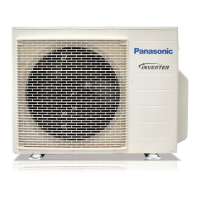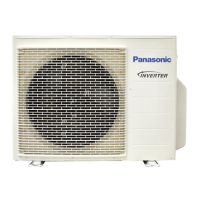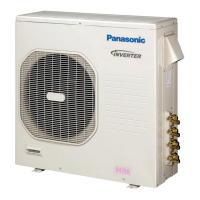Why outdoor unit emits water from Panasonic Air Conditioner?
- SShawn WolfeSep 15, 2025
The emission of water or steam from the outdoor unit of your Panasonic Air Conditioner is due to condensation or evaporation occurring on the pipes.
Why outdoor unit emits water from Panasonic Air Conditioner?
The emission of water or steam from the outdoor unit of your Panasonic Air Conditioner is due to condensation or evaporation occurring on the pipes.
Why plastic parts of Panasonic CU-3E18PBE Air Conditioner are discolored?
Discoloration of some plastic parts in your Panasonic Air Conditioner is subject to the material types used and is accelerated when exposed to heat, sunlight, UV light, or environmental factors.
What to do if the power cord of my Panasonic CU-3E18PBE Air Conditioner becomes unnaturally warm?
If the power cord of your Panasonic Air Conditioner becomes unnaturally warm, turn off the power supply, unplug the unit, and consult an authorized dealer.
What to do if the switches or buttons on my Panasonic CU-3E18PBE Air Conditioner are not functioning properly?
If the switches or buttons on your Panasonic Air Conditioner are not functioning properly, turn off the power supply, unplug the unit, and consult an authorized dealer.
Why does the Panasonic CU-3E18PBE Air Conditioner POWER indicator blink and stop in COOL/DRY mode?
If the POWER indicator blinks and stops when operating in COOL/DRY mode, it indicates that the system has locked to operate in HEAT mode only.
How to fix a Panasonic Air Conditioner remote control that does not work?
If your Panasonic Air Conditioner remote control isn't working, ensure the batteries are inserted correctly. If the display is dim or the transmission signal is weak, try replacing the batteries with new ones.
What causes the water flowing sound during operation of Panasonic CU-3E18PBE Air Conditioner?
The water flowing sound you hear during the operation of your Panasonic Air Conditioner is due to the flow of refrigerant inside the unit.
Why does airflow continue after operation has stopped on my Panasonic CU-3E18PBE?
The airflow continues even after your Panasonic Air Conditioner has stopped operating because the unit is extracting remaining heat from the indoor unit, which can take up to 30 seconds.
Why does my room have a peculiar odour when using my Panasonic CU-3E18PBE?
The peculiar odor in the room when using your Panasonic Air Conditioner may be due to a damp smell emitted by the wall, carpet, furniture, or clothing.
Why does the indoor fan stop occasionally during heating operation of my Panasonic CU-3E18PBE Air Conditioner?
The indoor fan of your Panasonic Air Conditioner stops occasionally during heating operation to avoid an unintended cooling effect.
Warnings and cautions regarding appliance use, injury, and property damage.
Safety precautions for remote control, Network Adaptor, and power supply.
Warning about the risks associated with flammable refrigerant R32.
Requirements for personnel handling refrigerants and safety for refrigerating circuits.
Guidelines for installation space, piping protection, and compliance with regulations.
Requirements for service personnel and safety procedures before starting work.
Procedures for checking refrigerant, fire extinguishers, ignition sources, and ventilation.
Checks for refrigerating equipment, electrical components, and earth bonding.
Safety for component repair, cabling, and flammable refrigerant detection.
Acceptable leak detection methods and procedures for refrigerant removal.
Procedures for charging refrigerant and decommissioning the equipment.
Requirements for labelling and recovering refrigerant safely.
Instructions on how to retrieve and interpret error codes displayed by the unit.
Conditions requiring consultation with an authorized dealer for service.
| Outdoor unit weight | 71000 g |
|---|---|
| Outdoor units quantity | 1 |
| Outdoor unit noise level | 47 dB |
| Outdoor unit dimensions (WxDxH) | 875 x 320 x 795 mm |
| Type | Air conditioner outdoor unit |
| Ionizer | No |
| Inverter technology | Yes |
| Refrigerating medium | R410A |
| Cooling capacity (max) | 18000 BTU/h |
| Air conditioner functions | Cooling, Heating |
| Cooling capacity in watts (max) | 7300 W |
| Cooling capacity in watts (min) | 1800 W |
| Heating capacity in watts (max) | 8300 W |
| Heating capacity in watts (min) | 1600 W |
| Cooling energy efficiency (EER, W/W) | 4.33 |
| Heating energy efficiency (COP, W/W) | 4.69 |
| Seasonal efficiency rating (cooling) (SEER) | 7 |
| Seasonal efficiency rating (heating) (SCOP) (Average heating season) | 4 |
| Noise level | 61 dB |
| Power consumption (cooling) (max) | - W |
| Power consumption (heating) (max) | 2110 W |
| Power consumption (heating) (min) | 320 W |
| Annual energy consumption (cooling) | 260 kWh |
| Annual energy consumption (heating) (Average heating season) | 1680 kWh |












